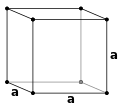Cubic crystal system


The cubic crystal system is one of the seven crystal systems in crystallography . It includes all point groups that each have a threefold rotational or rotational inversion axis in four different directions . These four threefold axes run in cubic crystals along the four spatial diagonals of the unit cells , the shape of which corresponds to a cube . Often (three) fourfold axes of rotation are given as a property of the cubic crystal system. This is true for the axis system and the abstract cubic lattices, but not generally for crystal structures, since there are cubic point groups that do not have fourfold symmetry.
Point groups
The cubic crystal system includes the point groups and . They form the cubic crystal family and can be described with the cubic lattice system .
Grid system
The cubic grid system has the holoedry . There is only one possibility that different three-fold axes can exist in a grid: as the spatial diagonals of a cube. Therefore the cubic grid has three right angles and three axes of equal length. So the following conditions apply:
They are generally listed in accordance with the standard specified in the International Tables for Crystallography . The cubic grid system is abbreviated with c (en: cubic).
Bravais grid
In cubic there are three Bravais grids , which are often referred to in the literature by their English abbreviation: the primitive (sc for simple cubic), the body-centered or body-centered (krz or bcc for body-centered cubic) and the face-centered (fcc for face centered cubic) grille.
Notes on the use of the term grid
The crystal structure is described by a lattice and a base. The lattice (also called space lattice or translation lattice) is the set of all translation vectors that transform a crystal into itself. The position of the atoms is described by the base. Crystal structures that not only have the same crystal lattice but also have the same layers (albeit with different atoms) form a structure type . Outside of the specialist literature, however, this difference between lattice and structure type is not always taken into account. In the case that there is only one atom in the unit cell that lies on the position (0,0,0), one speaks of a cubic primitive (or body-centered or face-centered) lattice as a structure type. If the base contains several atoms, one also speaks of nested cubic lattices.
While this use of the term is still reasonable, there are also terms and related ideas, especially on the Internet, that are definitely wrong.
- The points that are used to represent Bravais lattices do not represent atoms. There are structure types in which there is no atom at the origin of the lattice. (The best-known structure type with this property is the hexagonal closest packing of spheres (hcp))
- There are no cubic-primitive (body-centered or face-centered) crystal systems. The concept of centering refers solely to a grid.
- The terms hcp (hexagonal closed packed) and ccp (cubic closed packed) stand for spherical packings . These correspond to structure types. The information on coordination numbers and packing density only relate to these structure types. But there are no bars. In particular, fcc is not the same as ccp! There are many other structures that have a face-centered cubic lattice. The only correct thing is that the cubic closest packing of spheres can be described with a face-centered cubic lattice.
Representation through primitive grid
The centered cubic grids can also be described by primitive (albeit non-cubic) grids. The relationship between the primitive and non-primitive grid vectors is summarized in the following table. In each case, it is the lattice constant and not necessarily the length of the vector . The formula for the calculation can be found in the article on the reciprocal lattice
| Grid type | Real lattice grid vectors | Reciprocal lattice grid vectors |
|---|---|---|
| sc grid | ||
| bcc grid | ||
| fcc grid |
The reciprocal lattice of an sc lattice is thus again an sc lattice. The reciprocal lattice of an fcc lattice is a bcc lattice and vice versa.
Point groups in the cubic crystal system and their physical properties
To describe the cubic crystal classes in Hermann-Mauguin symbology , the symmetry operations are given in relation to given directions (viewing directions) in the lattice system. The viewing direction of the 1st symbol is the a- axis (<100>), of the 2nd symbol the room diagonal (<111>) and the 3rd symbol the area diagonal (<110>).
Characteristic for the cubic room groups is a 3 ( 3 ) in the 2nd position of the room group symbol.
| Point group (crystal class) | Physical Properties | Examples | ||||||||||
|---|---|---|---|---|---|---|---|---|---|---|---|---|
| No. | Crystal system | Surname | Schoenflies icon | International symbol ( Hermann-Mauguin ) |
Tepid class | Associated room groups ( no.) |
Enantiomorphism | Optical activity | Pyroelectricity | Piezoelectricity ; SHG effect | ||
| Full | Short | |||||||||||
| 28 | cubic | tetrahedral-pentagon-dodecahedral | T | 23 | 23 | m 3 | 195-199 | + | + | - | + |
Ullmannit sodium bromate |
| 29 | disdodecahedral | T h | 2 / m 3 | m 3 | 200-206 | - | - | - | - |
Pyrite Potash Alum |
||
| 30th | pentagon-icositetrahedral | O | 432 | 432 | m 3 m | 207-214 | + | + | - | - |
Maghemit Ye'elimit |
|
| 31 | hexakistrahedral | T d | 4 3 m | 4 3 m | 215-220 | - | - | - | + |
Sphalerite sodalite |
||
| 32 | hexakisoctahedral | O h | 4 / m 3 2 / m | m 3 m | 221-230 | - | - | - | - |
Diamond copper |
||
|
||||||||||||
For more cubic crystallizing chemical substances see category: Cubic crystal system
See also
literature
- International Tables for Crystallography . Vol. A: Theo Hahn (Ed.): Space-group symmetry. Kluwer Academic Publishing Company, Dordrecht et al. 1983, ISBN 90-277-1445-2 .
- D. Schwarzenbach: Crystallography. Springer, Berlin et al. 2001, ISBN 3-540-67114-5 .
- Walter Borchard-Ott: Crystallography. An introduction for scientists. 7th revised and expanded edition. Springer, Berlin et al. 2009, ISBN 978-3-540-78270-4 .
- Will Kleber , Hans-Joachim Bautsch , Joachim Bohm , Detlef Klimm: Introduction to crystallography . 19th edition. Oldenbourg Wissenschaftsverlag, Munich 2010, ISBN 978-3-486-59075-3 .
Web links
- cubic crystal system
- cubic crystals inscribed in a hexahedron
- all cubic crystal classes, their shapes and their stereographic projections (interactive Java applet)
- Calculation of packing densities of different cubic crystals
- Calculations of the packing densities in the body-centered and face-centered cubic crystal lattice - ChemgaPedia , FIZ CHEMIE Berlin
- Mineral Atlas: cubic (Wiki)

















